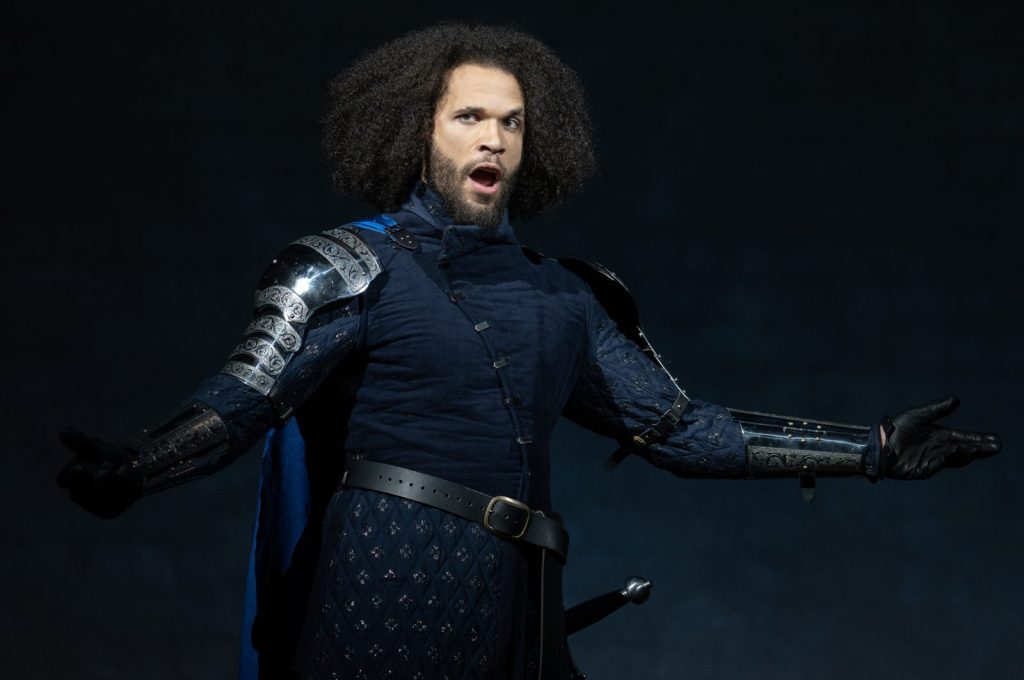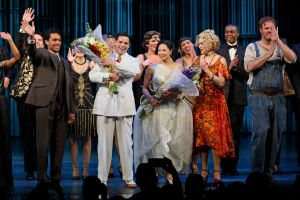The opening scene of Camelot is stark. White snow covers the floor, drifting past a gray sky; on stage, beneath curvaceous stone arches, stands a bench and a tree, shorn of leaves. It is a mood that is prescient of what is to come: an experience that is beautiful but empty.
Camelot first premiered in 1960, adapted from T. H White’s novel The Once and Future King. For this lavish revival, Aaron Sorkin has created a new book, departing from Alan Jay Lerner’s original, and teamed up with director Bartlett Sher. But, despite the retention of many of Frederick Loewe’s easy-to-the-ear songs, Camelot doesn’t know what it wants to be. Is it a frivolous comedy? A lovelorn tragedy? A study in good governance?
The plot follows the English King Arthur as he marries a French princess, Guenevere, and together they create the Round Table. It is a gathering defined not by hereditary birthright but by loyalty, justice and fairness. The law is sacrosanct — and no man, woman, king or queen, is exempt. Such lofty ideals are tested when Guenevere — who enjoys a respectful, platonic relationship with her husband — falls for the dashing knight Lancelot. Chaos ensues.
Sorkin has made some notable changes: he has shorn Camelot of magic (Morgan Le Fey is a scientist, not witch; Merlyn a wise old man, not wizard). He has added some witty repartee and a feminist sheen. And, in true West Wing fashion, he has emphasized strong, moral leadership.
Helping the musical along are two standout performances. Jordan Donica plays Lancelot as a prancing, preening dolt, whose egocentric song “C’est Moi” is bursting with riotous masculine energy. Yet he also grows into something more solemn when the time comes, showing a knight who, under all his bluster, is a devoted constant to the cause.
Matching him in vocal talent and sheer on-stage presence is Phillipa Soo (of Hamilton fame) as his crush Guenevere. Decked in costume designer Jennifer Moeller’s gorgeous outfits — a red velvet gown, a flirty off-the shoulder pink silk dress — she is a firecracker, smarter and more switched on than her husband. (When I visited, Tony-award winning Andrew Burnap, who plays the role of Arthur, was absent; his understudy Fergie Philippe was too weak for the part, trampled underfoot by Soo’s vitality.)
Despite such strong leads and a deceptively simple set by Michael Yeargan, with visionary projection by 59 Productions, Camelot is let down both by sloppiness (why do some characters have crisp British accents and others American drawls?) and a lackadaisical love triangle.
In the final act, Guenevere reveals she has loved Arthur all along, only driven into Lancelot’s arms by her husband’s seeming tepidity towards her. But wait! It turns out he loves her too. Arthur just didn’t want to force his affections on her, because that’s the kind of nice guy he is. It is all a little too… limp.
Part of the issue is that some of the most beautiful tunes (“If Ever I Would Leave You”, to name one) contain love lyrics between Guenevere and Lancelot (not Arthur), so the revelation falls flat. More important still is that there are no real stakes.
The consequences of the queen’s adulterous affair are rushed through in a single song, including a trial by jury, a judgement that she be “sentenced to the flame,” and a dramatic rescue by her lover, which results in war between England and France. None of these events are shown on stage. Even when Guenevere and Lancelot finally cross the line into a physical relationship, they are wheeled away in her four-poster bed as if their desire is something untoward, best not seen.
The result is I never believed that she was in danger. I never believed that their slip-up created a devastating conflict, leading to the death of thousands. And I certainly never believed that Guenevere and Arthur were in love all along, so the entire rupture was, in the end, for nothing.
The court of Camelot has fascinated artists and poets for centuries because it represents the corruption of an ideal: of men yearning to create something good, only for it to disintegrate under human pressure and passion. This Camelot, though, seems to flee, scared witless, from the very themes that have made the legend persist, and which make the story most compelling: namely, a shimmering kingdom led to ruin; love torn asunder; a fiery death thwarted by a hair’s breadth; and principles sullied.
For this reason, the musical is best in its first half, when it is little more than a Medieval romp: at least then it can revel in being frothy fun, with upbeat songs and sharp dialogue. Its true tragedy is that when it finally matters, and the action turns dark, it turns out that Camelot has nothing else to say.





















